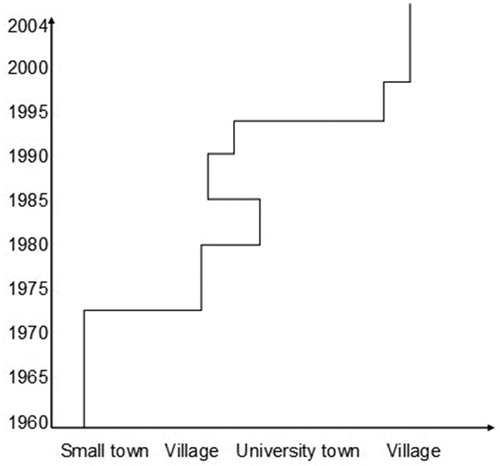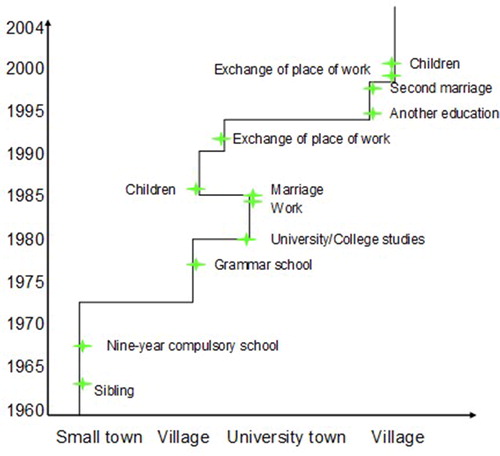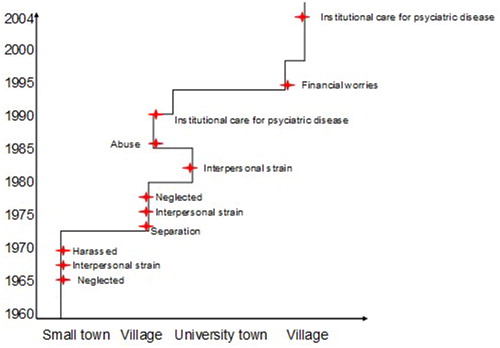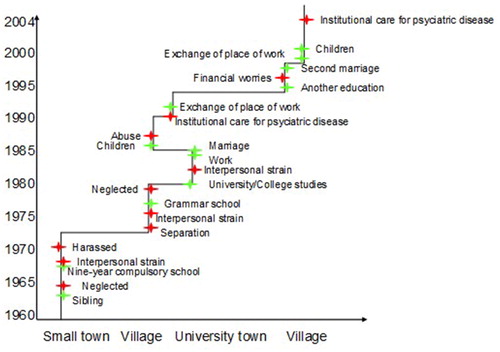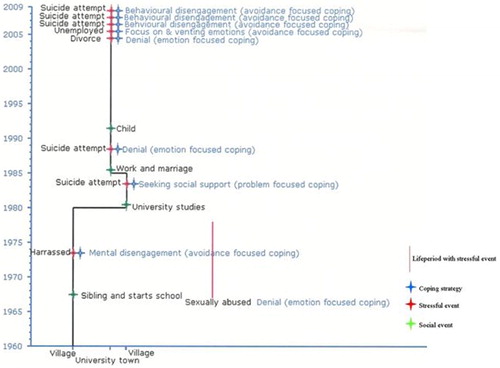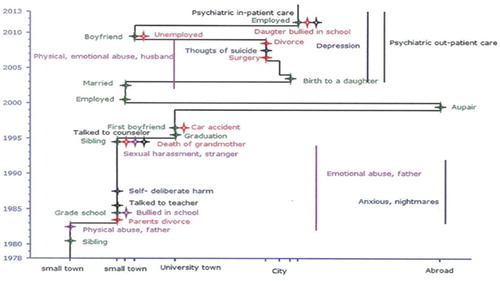Abstract
Patients’ life history is of primary interest in psychiatric nursing care. Our aim was to illustrate how we used time geography as a method to identify individuals' patterns in relation to certain situations in place. We have used interviews and diaries to construct life charts by hand and with a computer software program. By using time geography, we provide a rich amount of information, which can generate a broader picture of a person’s life, to identify stressful as well as social aspects of a person’s life. Patients with mental ill health need and value the therapeutic relationship using time geography.
Introduction
Mental ill health is a growing problem in Sweden, particularly for young people (Beckman et al., Citation2016; National Board of Health & Welfare, Citation2017). According to the National Board of Health and Welfare, persons with mental ill health should have access to balanced, knowledge-based and safe good-quality care. There are situations in which a person’s life, and the events during her/his lifetime, have a crucial impact on care, treatment or other decisions for action. However, a life story needs to be described in a well-structured and transparent way, so that the patient and health care staff together can gain an overview of a person’s life course and its social circumstances in time and place.
A theory that can help us understand why situations that occurred earlier in life have an impact when we are exposed to different precipitating stressful events, such as the onset of mental illness, is Bronfenbrenner’s (Citation1994) ecological systems theory. In this theory, he explains how different environments throughout a person’s lifespan may influence behavior to varying degrees. The system includes the microsystem (direct social interactions), the mesosystem (the relationships between the microsystems in one’s life), the exosystem (the link between the context wherein a person does not have any active role, and the context wherein a person is actively participating), the macrosystem (the actual structures affecting the individual), and the chronosystem (the transitions and shifts in one’s lifespan).
By means of a method called time geography human behavior can be described in relation to places in an ecological system with a historical dimension. By mapping a person´s life chart a person’s life chart, the micro and macro levels will be elucidated. Time geography, as explained by Hägerstrand (Citation1985), attempts to combine the spatial and temporal perspectives of different disciplines on a solid basis. It is a framework providing opportunities to chart individuals from a variety of populations in a multidimensional and abstract way (Ellegård & Svedin, Citation2012), and it sets time and space in focus by applying a conceptual apparatus elucidating people’s lives (Kjellman, Citation2003). The interaction of processes in time and space is analyzed in order to connect knowledge from different fields (Lenntorp, Citation1992). Furthermore, time geography has been used in medical research, and according to Schaerström (Citation1996, p. 125), life medical geography usually attempts to disentangle and explain the ecological and causal contexts of health, disease and environment by mapping spatial patterns of cases and potential pathogenic factors. We believe that patient´s life history, with a specific focus on space and time, are of primary interest in the field of medicine, due to patients’ difficulties communicating their needs and prior suffering throughout their life courses.
In addition to being a cartographic description of important experiences related to certain places in a lifetime perspective, or in a defined period of time, the essence of the method is to, together with a patient, identify her/his experiences in relation to certain situations and activities in relation to place. This means that besides being a purely descriptive method description, time geography also puts a focus on patients’ experiences of their own behavior in relation to place.
According to Hägerstrand (Citation1985), time geographical life charts offer a comprehensive and structured picture of a person’s life course. Life charting is a schematic method to describe a person’s life and illness course that was pioneered by Kraepelin (Citation1921, p. 280) and Meyer (Citation1948). Diaries and interviews are used to construct life charts focusing on a person’s movements in time and space. As the life chart is drawn together with the patient, it is a helpful and possibly therapeutic tool in the process of communication (Rämgård, Citation2009; Sunnqvist et al., Citation2007, Citation2013; Örmon, Citation2014).
A life chart follows each individual and places continuous events in time and space into focus. Moving is a significant event in a person’s life. Depending on the reason and distance, it can cause essential adjustment challenges, and therefore, it provides a good start for a lifeline (Lenntorp, Citation1992). Time geographical life charts can also be used to illustrate, e.g., social events, predisposing life events, stressful and precipitating life events. To recall such events, autobiographical memories must be activated. An autobiographical memory contains personal information concerning general or specific events in a person’s life history, and a person’s personal memory is the recollection of memories from specific episodes in his/her past and is connected to time and place (Brewer, Citation1986). The autobiographical knowledge base is structured into three levels: lifetime periods, general events and event-specific knowledge. These memories are activated by the time geographical life charting method, using the geographical sites for household moves as anchors.
In this article, we will describe how to use time geography in different care contexts related to mental ill health. Our aim is to illustrate how we, in four previous studies, used time geography as a method in psychiatric nursing care, to identify individuals’ patterns in relation to certain situations in relation to place.
Materials and methods
A total of 75 patients, in dementia care and in general psychiatric care, participated in our studies. We used interviews and diaries to construct the life charts of the patients in dementia care by hand, and the computer software program GeoLifeGraph® in combination with interviews for the patients’ in general psychiatric care.
In dementia care, 30 persons living in care units in three municipalities in southern Sweden were involved in an action research project, together with the nursing staff. The nursing staff wrote diaries about the persons’ cognitive abilities related to social activities in place and time. The data for the diaries were collected through observations of the older people with dementia. The diaries were structured in accordance with time geography principles. Also, in-depth interviews were conducted with the patients’ next-of-kin and focus groups comprising staff members were organized in the care units.
In a general psychiatric context at two university hospitals in the south of Sweden, 45 individual interviews were conducted using the software program GeoLifeGraph®. The program uses the X-axis to note geographical sites and the Y-axis marks the time during the life course described in years. The time geography life chart is semi-computerized, and the interviewer starts by asking the patients about their household moves and the reasons for moving, in a chronological perspective ().
After this, significant social events that occurred while living in each geographical place are added.
Subsequently, stressful events along the lifeline are entered, and the way in which each respective event affected the patients is noted.
Finally, the comprehensive lifeline with both social and stressful life events, connected to geographical moves, is presented to the patients, who are offered an opportunity to express their reactions and emotions.
Analysis
With regard to the research performed in dementia care, an inductive content analysis inspired by a constructivist grounded theory (Charmaz, Citation2006) was conducted by the researchers together with the staff, in order to uncover key categories from the focus groups, diaries and the interviews. All data were examined to identify codes through repeated reading. Similarly, codes from the material were grouped together to synthesize themes in the material. These themes were then examined through all the data.
Regarding the research conducted in general psychiatric care, we presented the result from the life charts at aggregated level. All events gained from the time geography life charts were analyzed by manifest content analysis according to Berg (Citation2009). By using manifest content analysis it is possible to identify the occurrences of events marked on the life chart. The manifest data are physically present in the material and countable, and they provide the surface structure that is the focus of manifest content analysis. Each life chart was separated into three age intervals of 0-12 years, 13-19 years, and 20 years and above.
Results
Rämgård (Citation2009) showed how people with cognitive impairments due to dementia disease change their behavior in relation to events in different places and how staff can use time geographical diaries to find places related to well-being for persons with cognitive difficulties. The findings indicate that patients’ well-being is strongly affected by their experiences in places during earlier phases of their lives. Additionally, emotionally charged experiences connected with certain places (such as churches, hairdressers, restaurants and primary care affiliations) influence their performance of social activities, strengthen their rational behavior (Rämgård, Citation2009). Time geography was thus a useful tool to create social well-being for persons in dementia care who have cognitive difficulties.
Time geography life charts
In another of the studies examined here, Sunnqvist et al. (Citation2007) used time geography life charts to explore the use of time geography life charts in clinical psychiatric practice. The study showed that time geographical life charts activate autobiographical memories: by merely asking about geographical moves through life, several events were discovered. The life chart also gave information on the person’s social capacity, as well as on predisposing stressful or precipitating life events. All informants gave their perceptions and benefits on the time geography life chart model, and almost all of them thought the model was positive. One participant thought it was important to recall and discuss social and stressful events in order to obtain a comprehensive picture of the entire life situation. Another participant thought this method could give the staff deeper knowledge than otherwise possible ().
A subsequent study by Sunnqvist et al. (Citation2013) used the life chart in combination with the pattern of coping strategies to illustrate an essential method to assess suicidality in mental care. The patients were subdivided into three subgroups according to the result of the COPE, a theory-based inventory produced by Carver et al. (Citation1989). A time geography life chart in combination with coping strategies showed different factors that should be covered in the assessment of suicide attempters. For example, these factors included life events that preceded the attempt; motives for the act; problems faced by the patient; family and personal history; current circumstances, for instance, social, domestic and occupational; psychiatric history; and coping resources and supports. The study identified three pathways to suicidal behavior by combining life charts and COPE inventories of patients after a suicide attempt: in the first pathway, predominantly adaptive coping capacities were used; in the second, both adaptive and maladaptive coping capacities were used; and in the third pathway, mainly maladaptive coping capacities were used ().
According to this study, the time geography life chart strengthens the comprehensive picture of the patient’s life situation. In addition to being a communication tool, it was also found to function as a therapeutic intervention for the patients, making them look back and reflect (Sunnqvist et al., Citation2013).
According to this study, the time geography life chart strengthens the comprehensive picture of the patient’s life situation. In addition to being a communication tool, it was also found to function as a therapeutic intervention for the patients, making them look back and reflect (Sunnqvist et al., Citation2013).
Experiences of abuse among women in a general psychiatric context
Finally, a life-chart study by Örmon et al. (Citation2015) aimed to investigate the life course of women within psychiatric care who have experienced abuse. The life charts revealed the school years as significant in growing up, and most of the women had had extracurricular activities. Other examples of resources could be friends, the first boyfriend, traveling and graduations. Later in life, marriage, children or a divorce were mentioned as significant events. Stressful events during the life course could be described in terms of a stressful childhood with alcohol or drug abuse, parents suffering from mental ill health, as well as parents’ divorce. Events described as stressful during adulthood were the loss of friends, loss of health, and unemployment. More than half of the women had experienced physical, emotional and/or sexual abuse during their life course. Fathers were the most common perpetrator during childhood, followed by boyfriends and husbands later in life. Adulthood was the period in life with most events of abuse marked on the life course. Mental ill health during childhood was reported as mild depression, anxiety, nightmares and fear. Nevertheless, self-reported mental ill health was only reported among those women who also reported abuse and other stressful events growing up. The women reported self-inflicted harm and suicidal ideation in adolescence, and as adults, they were diagnosed with psychiatric disorders. The life charts revealed that despite childhoods with abuse and stressful events, the women marked only a few incidents of support during the life course. During adulthood, the women turned to formal networks, such as psychiatric health care, for support ().
The participating women received a copy of their life charts, and they were invited back after 2-4 weeks and thereby given the opportunity to modify their life charts. Only a few modifications were made, and mainly concerning geographical names or dates. The women were positive about the time geography life charts. They reported wishing to use the life charts in contact with their formal networks. Identifying good as well as difficult times during the life course was also considered to be of therapeutic value (Örmon et al., Citation2015)
Discussion
Based on four studies with, in total, 75 individuals from different care contexts, we argue that time geography charts could be very useful in clinical mental health, not only as a research tool. The essence of time geography is to identify individuals’ life patterns in relation to certain situations and activities in time and place, as well as how the material and social environment affects people. By using time geography life charts, we acquire provide a rich amount of information regarding life history, which can generate a broader picture of a person’s life, in addition to being a useful tool for personnel in a variety of settings to identify stressful as well as social aspects of a person’s life. Furthermore, patients with mental ill health need and value the therapeutic relationship that arises between themselves and staff conducting the time geography life chart. The life chart can also help the patients not to have to tell their stories repeatedly in contact with authorities and health care services. Thereby, the patients can become more empowered and in control of life situations. We also argue, based on research presented in this study that memories from places earlier in life have a specific meaning in mental health, serving to anchor memory, and that time geography can be used as a method for focusing on situating memories. According to the Swedish Society of Nursing (Citation2017), all health care professionals should work for good-quality and safe health care using the six core competencies. One of the core competencies is person-centred care, which means that the patient is an expert on his/her life, and therefore, we need to listen to the patient’s narratives and her/his needs, possibilities and resources. Person-centred care is built on a relationship based on mutual respect and understanding and in accordance with a person’s self-esteem and wishes (Ekman et al., Citation2011). According to Gabrielsson et al. (Citation2015), person-centred care in a psychiatric setting has been defined as cultural, relational and recovery-oriented. The time geography life chart does, according to our previous studies (Sunnqvist, Citation2009; Örmon, Citation2014), incorporate all of those aspects conducive to developing person-centred care, and it can therefore be a good starting tool in patient recovery.
Much research in health geography and caring has also elucidated the fact that place plays an important part in patients’/clients’ health and how they create meaning in their daily lives (Milligan, Citation2012; Rämgård, Citation2009; Årestedt et al., Citation2016). In occupational therapy, time geographical diaries have also been used in combination with time geographical life charting to explore women’s patterns of everyday occupation, as well as relationships between different aspects of their patterns of daily occupations and health and well-being (Bendixen & Ellegård, Citation2014; Erlandsson, Citation2003). The life chart describes a comprehensive picture of a person’s life in relation to place, a detailed life situation from one time period to another depending on the material and social environment. In this framework, the geography of places serves as an anchor to frame the autobiographical memories (Rämgård, Citation2006, Citation2014). An autobiographical memory contains information concerning self-description, specific events, and general events, from different places. It contains memories stored episodically, which means that they originate from different events, for example, from different times, places, associated emotions, and other conception-based knowledge (Conway & Bekerian, Citation1987). Suicidal individuals, especially, seem to have inaccurate autobiographical memories related to their use of maladaptive coping strategies (Pollock & Williams, Citation2004; Evans, Williams, Schotte & Clum, Citation1987; Linehan, et al., Citation1987; Orbach et al., Citation1990; Ambrus et al., Citation2016; Ambrus et al., Citation2020). People suffering from dementia have often lost their spatial orientation, but by focusing on specific activities related to places, their memories are activated. The construction of life charts also provides an opportunity for identifying violence during a life course and thereby a possibility to process current and previous traumas.
Bronfenbrenner (Citation1994) explains, in his ecological systems theory, including the microsystem, mesosystem, exosystem, macrosystem and chronosystem levels, and the importance of the material as well as the social environment as an aid in understanding difficulties. The time geographical life chart clearly and graphically visualizes personal and relational events. The life chart also identifies geographical areas of interest. According to Elder (Citation1998), life-course research concerns “the real world”, a world where people live their lives, create their patterns and evolve as humans. Life-course research gives us knowledge of how life is socially organized in a biological and historical age and of the influence of the biological and historical age on how we think, feel and act; it is research that generates knowledge over generations, from early childhood into ages. Theoretical concepts resulting from Elder’s (Citation1998) research include “historical time and place”, which means that an individual’s life course is incorporated into, and created in relation to, historical time and place.
The relational attribute of psychiatric care and nursing is to build a relationship between the caregiver and the patient that is therapeutic, supporting, empowering and characterized by closeness and sincerity. Time geography life charts might be a helpful tool for achieving this, due to the necessity for the caregiver to listen to the patient’s narrative. The life chart offers a structured picture of the patient’s life and enables the patients to take part in their care.
The health care services of today are mainly focused on the present, which entails a loss of the continuity of past and present and thus of the individual’s personal journey, as well as implying a focus on how a person is instead of who he/she is. Therefore, there is a need for a method making it possible to gain information through the narrative of a person. Within humanized care, the life journey of a person is not ignored but supported, and the need for biographies is seen as important. The purpose of time geography is to connect knowledge from different fields. Thus, life charts provide a comprehensive picture of a patient’s life situation, with a rich amount of information regarding life history. By using the time geography life charting method, the life course of an individual can be visualized and defined, as well as being a useful tool for personnel in a variety of settings to identify stressful and salutogenic aspects of a person’s life. A biography of a long historical period helps us understand the circumstances of current events.
Implications for nursing practice
Time geography is a participatory model. This model makes patients cooperate with health professionals aiming for an effective person-centred psychiatric nursing care and increased well-being for patients. The result showed how the patients themselves, through time geographical life charts, can illuminate their own life story and see patterns of their own behavior in time and space. By using time geography, the nursing care is focused on the patient’s narratives and experiences during their life course. Through this method, nurses and patients can better identify social and stressful events, as well as coping strategies during the life course, and thereby tailor the nursing care and treatment individually. The time geography life chart is also a valuable instrument for both the nurses and the patients when creating the patient’s care plan together. Moreover, patients with mental ill health need and value the therapeutic relationship that arises between themselves and staff conducting the time geography life chart. A major problem within health care services is the focus on the present, which can be a hindrance to person-centred care. This is why time geography, whose focal point is the patient’s own life story in time and space, is a valuable method for psychiatric nursing care and well suited to a person-centred approach. We want to stress that time geography gives a fuller picture of a patient’s life course and thereby a more solid base for psychiatric nursing care.
Declaration of interest statement
The authors report no conflict of interest.
Acknowledgments
The authors want to express their gratitude to the informants participating in the study.
Data availability statement
The datasets generated and/or analyzed during the current study are not publicly available due to ethical considerations, but are available from the corresponding author on reasonable request.
References
- Ambrus, L., Sunnqvist, C., Asp, M., Westling, S., & Westrin, Å. (2020). Coping and suicide risk in high risk psychiatric patients. Journal of Mental Health, 29(1), 26–27. https://doi.org/10.1080/09638237.2017.1417547
- Ambrus, L., Sunnqvist, C., Ekman, R., Träskman-Bendz, L., & Westrin, Å. (2016). Plasma brain-derived neurotrophic factor and psychopathology in attempted suicide. Neuropsychobiology, 73(4), 241–248. https://doi.org/10.1159/000446286
- Årestedt, L., Benzein, E., Persson, C., & Rämgård, M. (2016). A shared respite: The meaning of place for family well-being in families living with chronic illness. International Journal of Qualitative Studies on Health and Well-Being, 11(1), 30308. https://doi.org/10.3402/qhw.v11.30308
- Beckman, K., Mittendorfer-Rutz, E., Lichtenstein, P., Larsson, H., Almqvist, C., Runeson, B., & Dahlin, M. (2016). Mental illness and suicide after self-harm among young adults: Long-term follow-up of self-harm patients, admitted to hospital care, in a national cohort. Psychological Medicine, 46(16), 3397–3405. https://doi.org/10.1017/S0033291716002282
- Bendixen, H. J., & Ellegård, K. (2014). Occupational therapists’ job satisfaction in a changing hospital organisation – A time-geography-based study. Work, 47(2), 159–171. https://doi.org/10.3233/WOR-121572
- Berg, B. (2009). Qualitative research methods for the social sciences. (7th ed.). Pearson Education.
- Brewer, W. F. (1986). What is autobiographical memory? In D.C. Rubin (Ed.), Autobiographical memory. (pp. 24–49). Cambridge University Press.
- Bronfenbrenner, U. (1994). Ecological models of human development. International Encyclopedia of Education (Vol. 3, 2nd ed.). Elsevier.
- Carver, S., Scheier, M., & Weintraub, J. (1989). Assessing coping strategies: A theoretically based approach. Journal of Personality and Social Psychology, 56(2), 267–283. https://doi.org/10.1037/0022-3514.56.2.267
- Charmaz, K. (2006). Constructing Grounded Theory: A practical guide through qualitative analysis. Sage.
- Conway, M. A., & Bekerian, D. A. (1987). Organization in autobiographical memory. Memory & Cognition, 15(2), 119–132. https://doi.org/10.3758/BF03197023
- Ekman, I., Swedberg, K., Taft, C., Lindseth, A., Norberg, A., Brink, E., Carlsson, J., Dahlin-Ivanoff, S., Johansson, I.-L., Kjellgren, K., Lidén, E., Öhlén, J., Olsson, L.-E., Rosén, H., Rydmark, M., & Sunnerhagen, K. S. (2011). Person-centred care-ready for prime time. European Journal of Cardiovascular Nursing, 10(4), 248–251.
- Elder, G. H. (1998). The life course as developmental theory. Child Development, 69(1), 1–12. https://doi.org/10.1111/j.1467-8624.1998.tb06128.x
- Ellegård, K., & Svedin, U. (2012). Torsten Hagerstrand's time-geography as the cradle of the activity approach in transport geography. Journal of Transport Geography, 23, 17–25. https://doi.org/10.1016/j.jtrangeo.2012.03.023
- Erlandsson, L.-K. (2003). 101 women’s patterns of daily occupations. Characteristics and relationships to health and wellbeing. [Thesis, Department of Clinical Neurosciences, Division of Occupational Therapy].
- Evans, J., Williams, J. M. G., O'Loughlin, S., & Howells, K. (1992). Autobiographical memory and problem-solving strategies of parasuicide patients. Psychological Medicine, 22(2), 399–405. https://doi.org/10.1017/S0033291700030348
- Gabrielsson, S., Sävenstedt, S., & Zingmark, K. (2015). Person-centred care: Clarifying the concept in the context of inpatient psychiatry. Scandinavian Journal of Caring Sciences, 29(3), 555–562. https://doi.org/10.1111/scs.12189
- Hägerstrand, T. (1985). Time-geography. Focus on the corporeality of man, society and environment. The science and praxis of complexity. The United Nations University, pp. 193–216.
- Kjellman, C. (2003). Ta plats eller få plats? (Summary in English) [Thesis, Institutionen för kulturgeografi och ekonomisk geografi (Department of Human Geography and Economic Geography)]. Report, 92, 7.
- Kraepelin, E. (1921). Manic-depressive insanity and paranoia. E. & S. Livingstone.
- Lenntorp, B. (1992). Biografier, diagnoser och prognoser. I Självmord som existentiellt Problem (Biographies, diagnoses and prognoses. In: Suicide as an existential problem (pp. 63–76). Folksams vetenskapliga råd, forskningsrådsnämnden. (The Scientific Board of Folksam, FRN).
- Linehan, M. M., Camper, P., Chiles, J. A., Strosahl, K., & Shearin, E. (1987). Interpersonal problem solving and parasuicide. Cognitive Therapy and Research, 11(1), 1–12. https://doi.org/10.1007/BF01183128
- Meyer, A. (1948). The life-chart. In The Commonsense Psychiatry of Dr Adolf Meyer (pp. 418–422). McGraw-Hill.
- Milligan, C. (2012). There’s no place like home: Place and care in an ageing society. Lancaster University.
- National Board of Health and Welfare (2017). https://www.socialstyrelsen.se/publikationer2017/2017-2-11
- Orbach, I., Bar-Joseph, H., & Dror, N. (1990). Styles of problem solving in suicidal individuals. Suicide & Life-Threatening Behavior, 20(1), 56–64.
- Örmon, K., Torstensson-Levander, M., Bahtsevani, C., & Sunnqvist, C. (2015). The life course of women who have experienced abuse – A life chart study in general psychiatric care. Journal of Psychiatric and Mental Health Nursing, 22(5), 316–325. https://doi.org/10.1111/jpm.12177
- Örmon, K. (2014). Experiences of abuse during the life course. Disclosure and the care provided among women in a general psychiatric context [Thesis, Faculty of Health and Society, Department of Care Sciences, Malmö University].
- Pollock, L. R., & Williams, J. M. G. (2004). Problem-solving in suicide attempters. Psychological Medicine, 34(1), 163–167. https://doi.org/10.1017/S0033291703008092
- Rämgård, M. (2006). The power of place. Existential crises and place security in the context of pregnancy. [Doctoral thesis, Lund University].
- Rämgård, M. (2009). The matter of place in dementia care. (Platsens betydelse för dementa), R&D Skåne Association of Local Authorities, Lund, series: Vol. 2009: 8.
- Rämgård, M. (2014). The power of place in the context of pregnancy. In A. Schærström, S. H. Jørgensen, T. Kistemann, Å. Sivertun (Eds.), Geography and health - A Nordic outlook (pp. 47–59). Universität Bonn, Institute for Hygiene and Public Health.
- Schaerström, A. (1996). Pathogenic paths? A time geographical approach in medical geography. Lund University Press.
- Schotte, D. E., & Clum, G. A. (1987). Problem-solving skills in suicidal psychiatric patients. Journal of Consulting and Clinical Psychology, 55(1), 49–54. https://doi.org/10.1037/0022-006X.55.1.49
- Sunnqvist, C., Persson, U., Lenntorp, B., & Träskman-Bendz, L. (2007). Time-geography: A model for psychiatric life charting? Journal of Psychiatric and Mental Health Nursing, 14(3), 250–257. https://doi.org/10.1111/j.1365-2850.2007.01071.x
- Sunnqvist, C., Persson, U., Westrin, Å., Träskman-Bendz, L., & Lenntorp, B. (2013). Grasping the dynamics of suicidal behaviour – Combining time-geographic life charting and COPE ratings. Journal of Psychiatric and Mental Health Nursing, 20(4), 336–344. https://doi.org/10.1111/j.1365-2850.2012.01928.x
- Sunnqvist, C. (2009). Life events, stress and coping. Suicidal patients in a time-perspective [Thesis, Department of Clinical Sciences, Division of psychiatry. Lund University].
- Swedish Society of Nursing (2017). https://www.swenurse.se/in-english/

